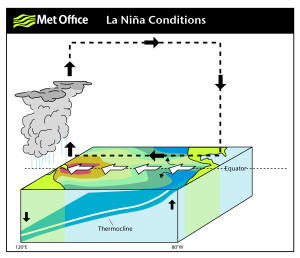July 2013:
Natural fluctuations in the Pacific ocean explain recent slowdown in global surface warming
A new article published in Nature adds to evidence that the recent slowdown in the rate of global warming at the Earth's surface is explained by natural fluctuations in the ocean and is therefore likely to be a temporary respite from warming in response to rising concentrations of greenhouse gases. This is important since it adds to a great body of research in continuing to confirm the realism of projected dangerous future warming in response human activities such as burning fossil fuels.
In an experiment using a detailed computer simulation of the climate, Kosaka and Xie artificially alter the flow of heat from the tropical east Pacific ocean to the atmosphere above so that sea surface temperatures in this region are forced to agree with observations. This results in the realistic simulation of the recent slowdown in the rate of global surface warming and also reproduces some unusual weather patterns such as the drought that has affected the southern USA.
Although the eastern Pacific is being given the correct ocean temperature in their simulations, this region only covers about 8% of the globe and their experiment highlights the importance of this region in determining natural fluctuations in climate that occur from one decade to the next.
The experiment does not show why the recent hiatus in global surface warming occurs, merely that this type of ocean change can explain the recent slowdown in global surface temperature rise. Free-running climate simulations (used to make future projections of climate change) are able to produce this type of variability but are not designed to predict the exact timings of these changes (see for example illustration by Ed Hawkings).
The study is also the first to bring together key pieces of
information crucial in understanding the warming
hiatus of the last 15 years, helping to explain the following:

Rearrangement of heating in the ocean is not dealt with in this study but this work provides more evidence that the recent slowdown in global surface warming is linked to changes in the Pacific ocean, particularly the upper few hundred metres rather than the deep ocean below 1000m (see recent discussion). We are currently investigating how this is happening in the DEEP-C project funded by the Natural Environment Research Council.
Ocean measurements and satellite data show that the planet is continuing to heat up ( Loeb et al. 2012, Nature Geosciences) despite the lack of warming near the Earth's surface. The recent slowdown in global surface warming appears to be explained by natural fluctuations in the Pacific ocean which have caused the additional heating from rising concentrations of greenhouse gases to temporarily affect the layers below the ocean surface rather than surface temperatures of the planet. Over the coming decades, a return to warming of global surface temperatures is extremely likely.
Richard P. Allan Location: Department of Meteorology (2U15)